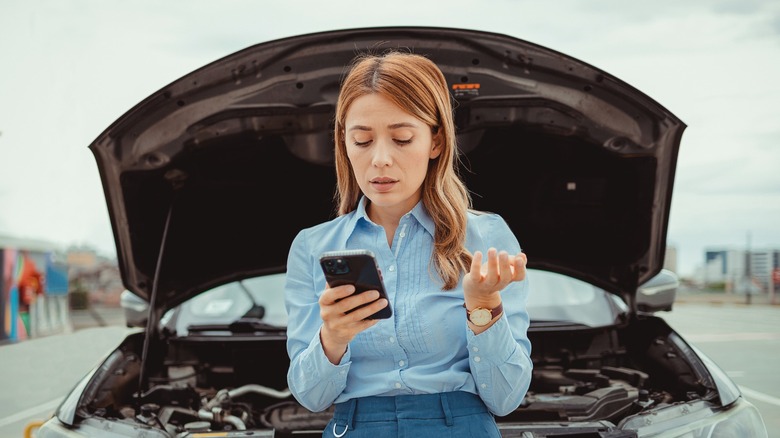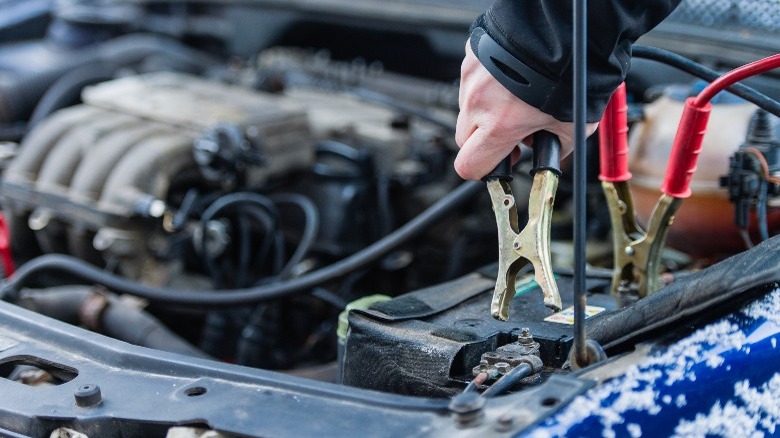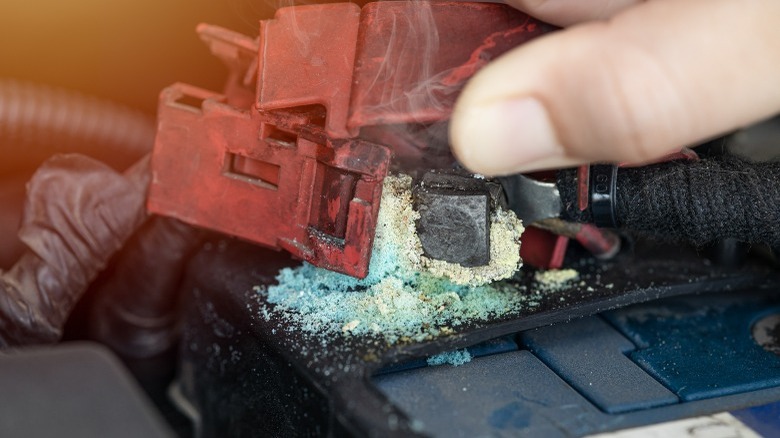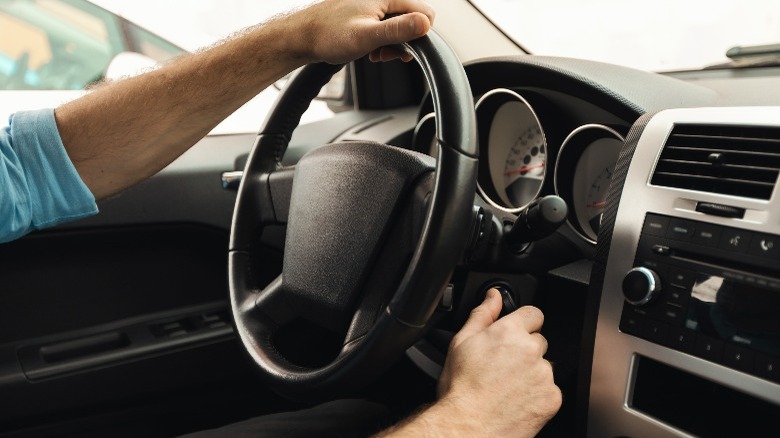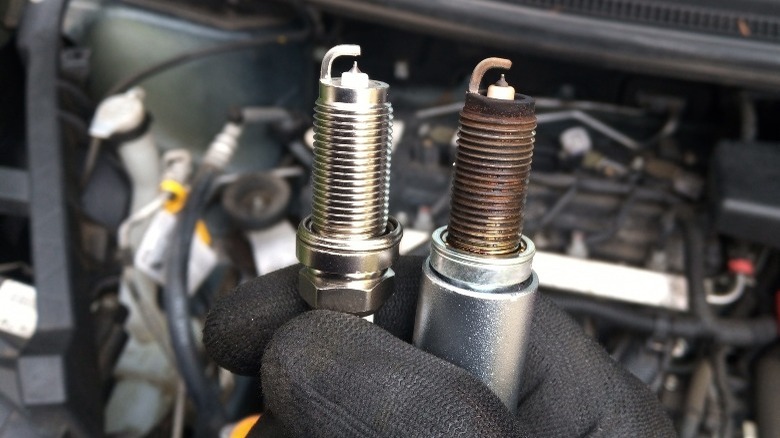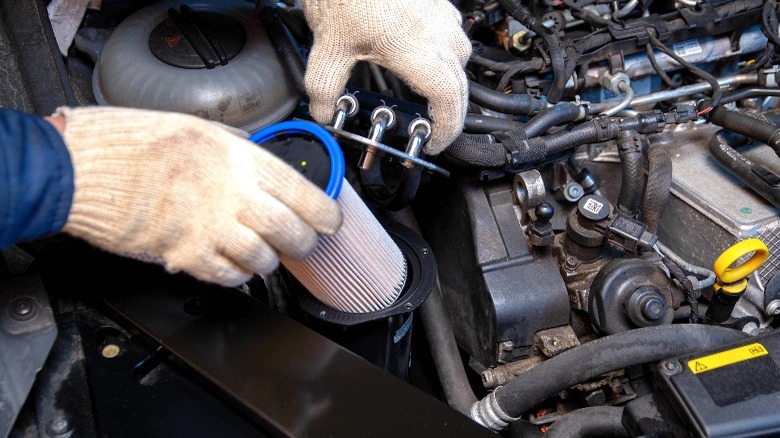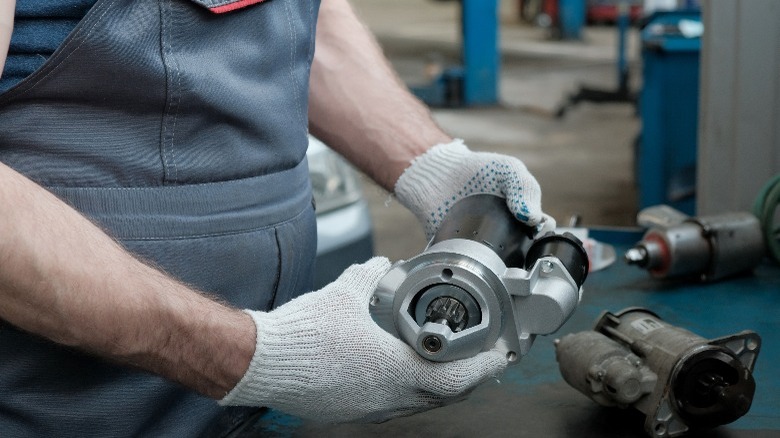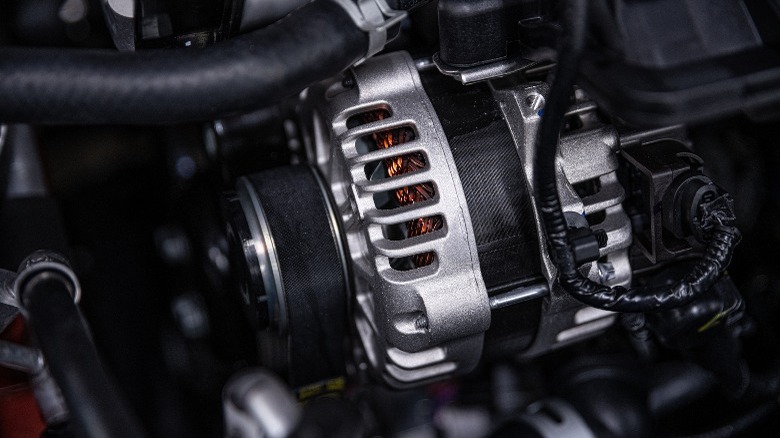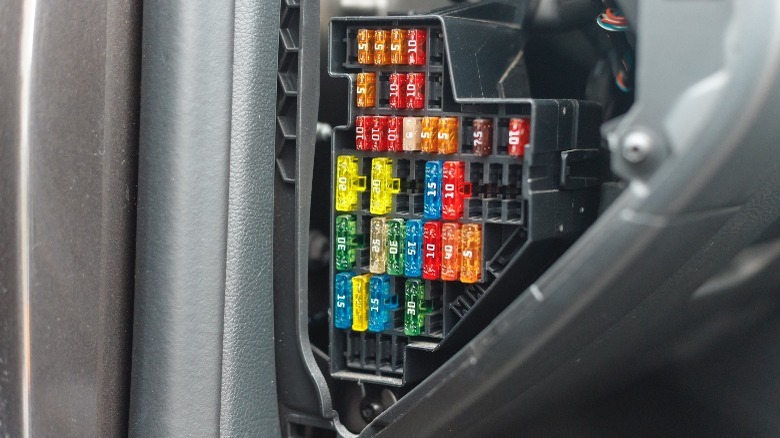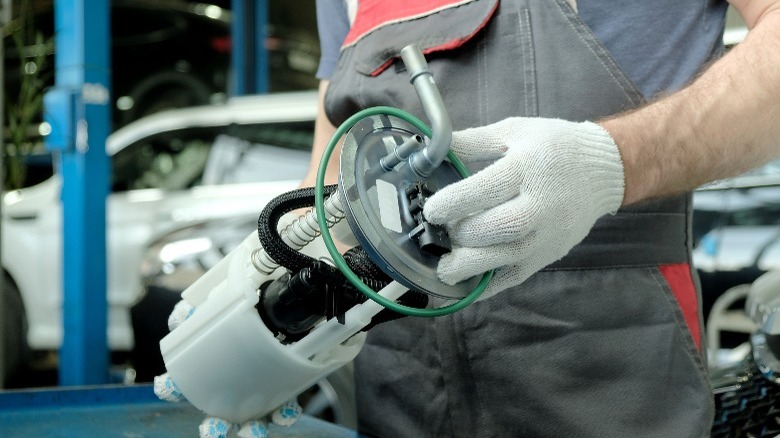10 Tips & Tricks To Troubleshoot A Car That Won't Start
Picture this — you're set to go out, and you try to start your car, but all you hear is a clicking noise. Even worse, nothing happens. Such a situation leaves you with two options. The first is waiting for a mechanic or towing service. The second is fixing it yourself. However, the sheer number of moving parts in your car means it's not as easy as switching out a light bulb. There's a high chance you can troubleshoot your vehicle and get it working again without a trip to the mechanic.
When your car doesn't start, it's usually due to a problem with one of the parts that gets to work when you trigger the ignition. This should come as no surprise because, as with wear and tear, something is bound to malfunction. This can be anything from your car's battery to its fuel pump, and for the most part, it's probably pretty easy to identify and fix yourself. Here are some common troubleshooting tips to try when your car won't start.
Jump start your car
Your car's battery powers the electrical units and starts the engine. Of course, like any other part, your car's battery won't last forever. Eventually, batteries weaken and won't hold enough charge to start the engine. More commonly, a drained battery is most likely the culprit.
Typically, your car battery charges whenever the engine is turned on. However, if you haven't used your car in a month or two, when you try to start the engine, it might not work because the battery has drained during this period. Another common cause is if you leave an electrical unit, like headlights, on for too long while the engine is off. It'll drain all the power from the car's battery, and your car won't start. Luckily, recharging your battery won't cost much. You can fix this by jump starting your car by using another car's battery as a source for an initial electrical charge and letting the engine recharge your battery.
To jump start your car, you'll need some jumper cables connecting your engine to another power source. They are usually labeled with a + and – sign or color coded so you know where to place the cables on your battery. Clip it onto the battery terminal and onto that of the battery you're using to jump start the car. Once you're done, start the engine again, and you should hear your vehicle's sweet purr or roar. After your car starts, leave the engine running for a bit so the battery can charge.
Clean corroded battery terminals
Sometimes, your car's battery is in good condition, but if you take a closer look at the terminal connecting it to the rest of the car, you'll notice a whitish or greenish and possibly even bluish powdery substance surrounding it. This is evidence of corrosion, which is caused by overheating and leaking fluids and is more common with older batteries.
While the battery terminal may seem minor, it distributes power from the car battery to the rest of the vehicle, so a corroded terminal will interrupt your vehicle's electrical system. With enough time it can even prevent your car from starting.
So, if you notice corrosion on your battery terminal, you can clean it yourself with some household items. First, mix a spoonful of baking soda with water. You'll use this mixture to clean the affected area. Disconnect both terminals, then use a brush dipped in your solution to scrape away the corrosion gently. When you're done cleaning the terminal, apply some grease, and then reconnect the terminals. However, where the corrosion is persistent and the damage increases, despite regular maintenance, you may need to replace the terminals completely. In this case, it is advisable to get expert help.
Jiggle the steering wheel
Sometimes, the problem may be that your key won't even turn when you place it in the ignition. Despite what you may think, this is a common problem and, thankfully, one that comes with an easy fix. First, it is important to learn why the key refuses to turn. Understanding it will help you solve the issue and potentially prevent it from happening again.
Essentially, an ignition key initiates the flow of current to the starter motor, which starts the engine. This enables the current to flow through the ignition system. If the ignition key cannot do this, a common cause is a stuck steering wheel. Many steering wheels are programmed to lock once the ignition key is removed from the slot, causing the wheel to remain in a position. However, where the steering is not aligned straight, it may pose a problem. This often happens when you park your car and forget to realign the steering and straighten the tires.
Now that you understand why it happens, you can firmly jiggle the steering wheel while trying to turn the key in your ignition. After some consecutive rocking of the steering and a soft wiggling of the ignition key, the key will eventually turn, the steering wheel will unlock itself, and the car should start.
Clean the spark plug
A spark is one of three elements necessary for an internal combustion engine making spark plugs an important part of your car. However, over time, they can become faulty or dirty. If this is the case you'll probably notice that your engine stalls when you start the car. The next step is to either clean or replace the old spark plugs entirely.
To clean your spark plug, start by removing the engine cover and then the ignition coil. Spark plugs tend to get stuck, so you can spray some WD-40 on them and let them sit for a few minutes to make removing them easier. After taking them out, wipe them clean and place them back in.
Replacing spark plugs, on the other hand, isn't an exact science. It'll depend on the plug type, the gasoline your vehicle uses, and mileage. However, the average spark plugs need to be changed every 30,000 to 55,000 miles, depending on the make. If you suspect that your car has a bad spark plug where it has not hit the estimated mileage mark, there are some ways to find out just by looking at it. For instance, if you notice black soot on your spark plug or a burnt insulator tip when cleaning, that's a good sign that you need to replace your spark plugs.
Fill up your tank
Sometimes, your car troubles don't require a mechanic or professional — you may have just run out of gas. If this is the case, you'll probably notice your car jerking, struggling to accelerate, and even the engine making a coughing sound. While you definitely don't plan to run out of fuel, sometimes these things just happen.
For example, you might lose track of how much fuel you are using while stuck in traffic for longer than expected, a fuel leak may drain your tank, or a faulty fuel gauge could catch you by surprise. To prepare for the worst, you can keep a fuel canister and a funnel in your car's trunk. This way, if you have gas issues, you can use the canister to get gas at the nearest gas station. Once you've bought fuel, you can use the funnel to pour it into your tank carefully.
To avoid getting in this situation, regularly check your car for fuel leaks or a wrong odometer reading. Avoid letting your tank drop below the one-third mark. That way, you will have enough fuel for those unexpected trips.
Replace your fuel filters
If your car won't start you can check for a clogged fuel filter. In the same way that you would use an air filter to purify your air from dust and debris, a fuel filter does that to the fuel you put into your tank. While its location may vary, it is usually found between the fuel tank and the engine. Since they serve as purifiers, it is only makes sense that they can get clogged after some time.
If the filters stay clogged for too long, they will begin to hinder fuel flow, which means your car won't be able to circulate the fuel it needs to start. It is necessary to replace your fuel filters frequently. To replace your fuel filter, turn off the engine, then disconnect the negative connector from your battery terminal — this is to prevent any sparks during the process. Locate your fuel filter then place a bucket under it to collect any fuel that may spill during the process
Disconnect the fuel line and let any excess fuel fall into your bucket then use then remove the filter from its position. You may need to use a spanner depending on your car's model. Once the fuel filter is out, release any fuel that may still be in it. You should now be able to insert the replacement filter.
Test the starter
The starter in your car acts like the middle man between the battery and the engine, and as the name says, it starts your engine. If your starter is faulty, you'll notice the electrical units of your car like the radio or the lights still work but the engine won't start. You may also notice a clicking sound when you try starting your car
Problems with your starter are usually caused loose wiring, battery corrosion, oil leaks, or a bad relay. If you have a bad starter you'll probably need professional help but there are still temporary fixes you can use to start the engine. You can start by finding the starter motor — which is usually in your vehicle's hood — and tapping it with a hammer or another tool to get it working. It's just like the movies where banging on a machine can get it working again.
Test the alternator
If you've ever had issues with your battery you probably heard the word alternator tossed around. So what exactly is an alternator? That's the part of your car battery that keeps it charged when you turn on the engine. If you have starter issues or your car battery runs down even after a jumpstart, the problem is probably with the alternator. One common way to identify this is if you notice battery warning lights on your dashboard. You can also notice a bad alternator when your headlights start flickering from being overly bright to suddenly becoming dim.
While a regular jump start isn't a viable solution, it is the quickest fix, especially if you're stranded. Ensure you jump start and keep the cables on for a couple of minutes so your battery can charge for a bit. Afterwards, it's advisable to drive directly to your mechanic's workshop so the battery doesn't run down elsewhere.
Check the fuse box and relays
You've probably had a fuse blow at home, which results in the power going off. Fuses in your home protect your appliances from electrical surges that can damage them and it's the same with your car. The car's fuse box has an array of fuses and relays that keep the electrical components in your car safe. It works by interrupting any unusual flow of electricity down a circuit, but the result of this is a blown fuse. Sadly, a blown fuse may mean not enough power would reach your car's starter relay, and your car won't start.
If your car refuses to start, you can pop the hood and check the fuse box for any blown fuses. One way to identify a blown fuse is to check inside it. There is a small metal strip that melts when there is super-high current — this makes up the filament. If you check and find the metal strip still intact, the fuse is still good, but if otherwise or the filament is broken, the fuse is blown. Replacing the blown fuse will get your car running again, although its also important to get your car to a mechanic so they can figure out the root of the problem.
Similarly if your fuel pump relay is bad your car would have trouble starting. Relays are found in the fuse box and there are multiple so you can try swapping your fuel pump relay with another one to see if it'll work.
Check the fuel pump
The fuel pump directs fuel from the tank to where it needs to be. Without this component doing its job properly, your car won't start. If your fuel pump gets bad, you'll probably realize the signs before it gives up. For example, you may experience sputtering or jerking, power loss during movements, and a strange noise from the fuel tank. Sometimes, the fault may be from the fuel filters, injectors, and the fuel pump relay, so it's important to check all three before moving forward.
Depending on the damage to the fuel pump, you can explore several solutions. The most advisable solution is to replace the fuel pump outright, especially if the pump is badly damaged beyond reasonable repair. While it may seem costly, it is better than the embarrassment a faulty fuel pump can cause. Another viable solution is a fuel pump repair, which is great for only minor fuel pump damage, but you'll have to contact a mechanic to help you with this. Your fuel pump should last a span of a 100,000 miles, to preserve it's life span make sure you always buy fuel from reputable gas stations.
